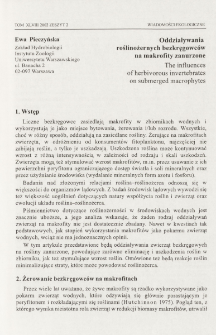
Object
Title: Oddziaływania roślinożernych bezkręgowców na makrofity zanurzone
Subtitle:
Influences of herbivorous invertebrates on submerged macrophytes ; Oddziaływania bezkręgowców na makrofity
Contributor:
Polska Akademia Nauk. Instytut Ekologii
Publisher:
Oficyna Wydawnicza Instytut Ekologii PAN
Place of publishing:
Description:
Type of object:
Abstract:
Multiple (both beneficial and detrimental) influences of herbivorous invertebrates on submerged freshwater macrophytes are reviewed and discussed on the basis of the literaturę. Traditionally, direct herbivory on living macrophytes has been considered unimportant, it having been assumed that the majority of herbivores prefer to feed on senescing plants, detritus of plant origin and the periphyton colonising macrophyte surfaces. However, morę recent reviews of this topie show that consumption of live macrophytes by animals may be a widespread phenomenon, of importance in determining macrophyte abundance.The extent of herbivory was shown to vary broadly both among species and among water bodies. The largest noted reductions in macrophyte biomass were usually caused by vertebrates (fish and birds) and large invertebrates (crayfishes), but the impact of other invertebrates may also be important.Macrophytes can be eaten without being killed, and at most sites animals consume only part of the available plant biomass. Many grazers destroy much morę tissue than they eat. Fragmentation, defoliation, loss of leaf area (holes, surface abrasion) and canals from mining animals have been observed in many localities. Secondary effects of the partial consumption of plant tissue are also of great importance. These include infections of grazing scars by microorganisms or further destruction caused by wave action. Depending on the type and scalę of injury, as well as the internal and external factors determining tolerance to herbivory, plants damaged during grazing may experience a limitation of growth (or even die in some cases) but may also continue to grow, in some cases even faster than plants remaining undamaged. In contrast to the rich literaturę on terrestrial plants, there is only very scarce information on post-damage growth in freshwater macrophytes. However, it is known that some macrophytes can regenerate fiom smali fragments, and that fragmentation may be very important in plant propagation. The further fate of plant fragments depends primarily on the production of new lateral shoots. In many cases after the shoot fragments have died, the young lateral shoots detaching from them continue to grow and form new viable plants. Plant fragments detached in the course of feeding can remain within the parental population or may float away, with some of them fal ling to the bottom while others float in the water column. Thus, the post-damage survival and growth of plants are strongly influenced by environmental conditions.The extent of herbivory is influenced by both the constitutive and induced defences of macrophytes. Plant structure (morphology, toughness), chemistry and nutritional value are determinants of animal feeding choices. Although most of the work on plant defences against herbivores derives from studies of terrestrial ecosystems, it has recently been accepted commonly that freshwater macrophytes are defended chemically against herbivores. Many classes of Chemical deterrents have been found in aquatic plants, but direct Chemical interactions between macrophytes and their consumers are documented in only a few cases.The beneficial effects of herbivores on macrophyte growth are primarily associated with the removal of the periphyton colonizing the macrophyte surface, as well as with the enrichment of the nutrient pool, mainly in nitrogen and phosphorus released by feeding invertebrates […].
Relation:
Volume:
Issue:
Start page:
End page:
Detailed Resource Type:
Resource Identifier:
oai:rcin.org.pl:229165 ; 0013-2969
Source:
MiIZ PAN, call no. P.3259 ; click here to follow the link
Language:
Language of abstract:
Rights:
Creative Commons Attribution BY 3.0 PL license
Terms of use:
Copyright-protected material. [CC BY 3.0 PL] May be used within the scope specified in Creative Commons Attribution BY 3.0 PL license, full text available at: ; -
Digitizing institution:
Museum and Institute of Zoology of the Polish Academy of Sciences
Original in:
Library of the Museum and Institute of Zoology of the Polish Academy of Sciences
Projects co-financed by:
Access:
Object collections:
- Digital Repository of Scientific Institutes > Partners' collections > Museum and Institute of Zoology PAS > Scientific Journals
- Digital Repository of Scientific Institutes > Literature > Journals/Articles
Last modified:
Jun 6, 2022
In our library since:
Oct 29, 2021
Number of object content downloads / hits:
159
All available object's versions:
https://www.rcin.org.pl/publication/173742
Show description in RDF format:
Show description in RDFa format:
Show description in OAI-PMH format:
| Edition name | Date |
|---|---|
| Z. 2. Oddziaływania roślinożernych bezkręgowców na makrofity zanurzone / Pieczyński E. | Jun 6, 2022 |
Objects Similar
Kornijów, Ryszard
Soszka, Grzegorz Jan
Goszczyński, Jacek
Sterzyńska, Maria Pilipiuk, Irmina (1948– )
Hillbricht-Ilkowska, Anna
Łuczak, Jadwiga

 INSTYTUT ARCHEOLOGII I ETNOLOGII POLSKIEJ AKADEMII NAUK
INSTYTUT ARCHEOLOGII I ETNOLOGII POLSKIEJ AKADEMII NAUK
 INSTYTUT BADAŃ LITERACKICH POLSKIEJ AKADEMII NAUK
INSTYTUT BADAŃ LITERACKICH POLSKIEJ AKADEMII NAUK
 INSTYTUT BADAWCZY LEŚNICTWA
INSTYTUT BADAWCZY LEŚNICTWA
 INSTYTUT BIOLOGII DOŚWIADCZALNEJ IM. MARCELEGO NENCKIEGO POLSKIEJ AKADEMII NAUK
INSTYTUT BIOLOGII DOŚWIADCZALNEJ IM. MARCELEGO NENCKIEGO POLSKIEJ AKADEMII NAUK
 INSTYTUT BIOLOGII SSAKÓW POLSKIEJ AKADEMII NAUK
INSTYTUT BIOLOGII SSAKÓW POLSKIEJ AKADEMII NAUK
 INSTYTUT CHEMII FIZYCZNEJ PAN
INSTYTUT CHEMII FIZYCZNEJ PAN
 INSTYTUT CHEMII ORGANICZNEJ PAN
INSTYTUT CHEMII ORGANICZNEJ PAN
 INSTYTUT FILOZOFII I SOCJOLOGII PAN
INSTYTUT FILOZOFII I SOCJOLOGII PAN
 INSTYTUT GEOGRAFII I PRZESTRZENNEGO ZAGOSPODAROWANIA PAN
INSTYTUT GEOGRAFII I PRZESTRZENNEGO ZAGOSPODAROWANIA PAN
 INSTYTUT HISTORII im. TADEUSZA MANTEUFFLA POLSKIEJ AKADEMII NAUK
INSTYTUT HISTORII im. TADEUSZA MANTEUFFLA POLSKIEJ AKADEMII NAUK
 INSTYTUT JĘZYKA POLSKIEGO POLSKIEJ AKADEMII NAUK
INSTYTUT JĘZYKA POLSKIEGO POLSKIEJ AKADEMII NAUK
 INSTYTUT MATEMATYCZNY PAN
INSTYTUT MATEMATYCZNY PAN
 INSTYTUT MEDYCYNY DOŚWIADCZALNEJ I KLINICZNEJ IM.MIROSŁAWA MOSSAKOWSKIEGO POLSKIEJ AKADEMII NAUK
INSTYTUT MEDYCYNY DOŚWIADCZALNEJ I KLINICZNEJ IM.MIROSŁAWA MOSSAKOWSKIEGO POLSKIEJ AKADEMII NAUK
 INSTYTUT PODSTAWOWYCH PROBLEMÓW TECHNIKI PAN
INSTYTUT PODSTAWOWYCH PROBLEMÓW TECHNIKI PAN
 INSTYTUT SLAWISTYKI PAN
INSTYTUT SLAWISTYKI PAN
 SIEĆ BADAWCZA ŁUKASIEWICZ - INSTYTUT TECHNOLOGII MATERIAŁÓW ELEKTRONICZNYCH
SIEĆ BADAWCZA ŁUKASIEWICZ - INSTYTUT TECHNOLOGII MATERIAŁÓW ELEKTRONICZNYCH
 MUZEUM I INSTYTUT ZOOLOGII POLSKIEJ AKADEMII NAUK
MUZEUM I INSTYTUT ZOOLOGII POLSKIEJ AKADEMII NAUK
 INSTYTUT BADAŃ SYSTEMOWYCH PAN
INSTYTUT BADAŃ SYSTEMOWYCH PAN
 INSTYTUT BOTANIKI IM. WŁADYSŁAWA SZAFERA POLSKIEJ AKADEMII NAUK
INSTYTUT BOTANIKI IM. WŁADYSŁAWA SZAFERA POLSKIEJ AKADEMII NAUK


































